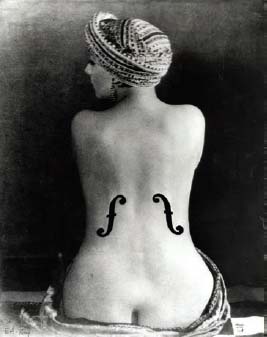The Modern World During and After the World Wars, C. 1914–1960Dada and Surrealism |
Who was Man Ray? |
Born Emmanuel Radnitsky (1890–1976) in Philadelphia, Man Ray was a major contributor to both Dada and Surrealism. Though he is most well known for his experimental photography, Man Ray was a painter, filmmaker, and writer. Like many other Dada artists, Ray was inspired by industrialism and the aesthetic qualities of machines, creating startling Dada objects such as Gift (1921), an iron with a row of sharp nails glued to the flat surface. He used tools more often associated with commercial art in his fine art projects, and was the first painter to use an airbrush, a process that fascinated him as it allowed him to create a painting without touching the canvas itself.
Man Ray is notable for his experiments with a camera-less photographic process known as the photogram, but which he called the “Rayograph.” With the Rayograph, Man Ray could place an object next to light-sensitive paper to create automatic images. He also developed photomontages and mixed media photographs such as Le Violon d’Ingres (1924), perhaps his most well-known work. The title refers to the nineteenth-century French artist who often portrayed exotic women in his portraits. Man Ray’s piece is a photograph of one of his favorite models, Kiki de Montparnasse (born Alice Prin), upon which he painted the f-holes of a violin, making her curving nude body reminiscent of a musical instrument. The image is oddly disturbing, as Kiki’s arms are noticeably missing from view and she is transformed from a subject into an object.

Le Violon d’Ingres (1924) is an innovative, mixed-media photograph by the American artist Man Ray. With only subtle manipulations, Man Ray creates a multi-faceted image that also becomes a play on words. In French, “le violon d’Ingres” is an idiom that means “hobby.” (Art courtesy The Bridgeman Art Library, © 2013 Man Ray Trust / Artists Rights Society (ARS], NY/ ADAGP, Paris.)
